Report from Ralph and Brenda Todd on the RSPB Bexley Group’s walk along the River Shuttle and into Bexley Park Woods on Tuesday 16th May 2017:
Report from Ralph and Brenda Todd on the RSPB Bexley Group’s walk along the River Shuttle and into Bexley Park Woods on Tuesday 16th May 2017:
Local butterfly recorders are beginning to work together to build a better picture of the distribution, flight period and numbers of Bexley’s butterflies. Mike Robinson has been collating available data to produce a list of first sightings for the year for each species (to end of March), an overall sightings log and a Small Tortoiseshell log, all of which are provided below. For details of how to contribute sightings, message Mike through his Facebook page here:
https://www.facebook.com/profile.php?id=100015053893361&fref=ufi&rc=p
Meanwhile both Crossness Nature Reserve on Erith Marshes (Karen Sutton karen.sutton@thameswater.co.uk) and Braeburn Park (London Wildlife Trust) in Crayford (contact Shaun Marriott smarriott@wildlondon.org.uk, mob: 07710194268) are seeking people who are willing to identify and record the numbers of butterflies on set routes on a regular basis so as to be able to determine population trends at these particular sites and contribute to London-wide data. The good news is you’re only supposed to do this in weather suitable for butterfly flight, so you’re not tied to going out on what might be a rainy day …. Training provided. YOU DO NOT HAVE TO BE AN EXPERT to help with this, most species are fairly distinctive and you could do it with a friend.
FIRST SIGHTINGS
GENERAL SIGHTINGS LOG
SMALL TORTOISESHELL SIGHTINGS REPORT
Chris Rose
Ralph and Brenda Todd report on a chilly April bird walk at Foots Cray Meadows.
As reported from other sites, Reed Warbler is back in Bexley from its African wintering grounds, and a few could be heard chuntering from out in the reedswamp at Thames Road Wetland on April 12th. A Cetti’s Warbler was present as usual, and there were a few others along the river and nearby.
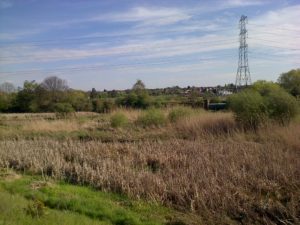
Reed Warblers swop Africa for the urbanised surroundings of Crayford in spring and summer. (Photo: Chris Rose)
Of note was what may well be the first record of an adult Damselfly or Dragonfly in the Borough this year – a teneral (recently emerged) individual which didn’t stick around to be identified but was almost certainly a Large Red Damselfly.
The Green Hairstreak butterfly was first recorded at Thames Road Wetland last year by David Courtneidge of LWT and myself. The sighting of another on this sunny afternoon raises hopes that a small colony may be establishing on or around the area. Bexley hotspots for it are Crossness and the Crayford Rough/Braeburn Park complex. A male Orange Tip was seen on the site, another species first noted here in 2016, in that case by Joe Johnson. A Speckled Wood, 1 or 2 Small Tortoiseshell and a Peacock or two were also present.
Several plants of Star of Bethlehem – a bulbous perennial – had been present on the hot, gravelly Thames Road bank when I took on the role of Site Manager in 2010, but most were smothered by a pile of bricks put in by contractors for a reptile hibernaculum. I was interested see 4 flowering plants appear last spring, and very surprised to find 13 in flower now. The leaves are thin and grassy, so difficult to spot when not in bloom. There is some doubt as to whether it is native or not, and if so it has a very restricted natural distribution in the UK. In any case it will be a garden escape via road embankment aggregate here, along with a couple of varieties of Grape Hyacinth.
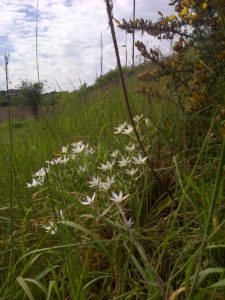
Star-of-Bethlehem, a garden escape, seems to be bouncing back at Thames Road Wetland after almost being lost. (Photo: Chris Rose)
A further six plants of the nationally scarce Marsh Sow-thistle were planted out, in this case ones which had somewhat miraculously come up in cracks in my front door step brickwork last spring from a plant I have been growing in a large pot nearby. The same hasn’t happened again, but it’s been a very dry start to the year …. The original and other subsequent plantings of the species at the site are leafing out nicely, with the oldest specimens having gone in back in May 2011 and now powering up to send their flower stems skywards to a height of around 9 feet over the summer.
Chris Rose. Thames21 Thames Road Wetland Site Manager.
Conservation group (full submission below) reiterates its objection to the Old Farm Park sell-off and sham consultations, highlights the need for new developments to be zero carbon, criticises the fact that one sixth of the land being taken over will be used for car parking, calls for strict controls on exterior lighting and argues for an emphasis on native vegetation in the remaining part of the park instead of the rather motley, and in some instances bizarre selection of exotics proposed for planting by ‘landscape architects’ – the extent of use of which is not clear from the documentation.
More than 80% of the public support the idea of councils cutting grass areas less frequently to protect the nation’s bees, according to a survey by Friends of the Earth and Buglife.
http://www.publicfinance.co.uk/news/2017/04/councils-urged-save-bees-not-cutting-grass
Meanwhile the Bexley Conservative administration is set to spent £90K per annum on more frequent grass mowing and more frequent hedge cutting under its ‘cleaner and greener’ mantra.
Given that the Council has already admitted that it re-let the current grounds maintenance contract a couple of years ago without taking biodiversity issues into account, despite being asked beforehand to consult Friends Groups through Bexley Natural Environment Forum, and given that it has subsequently ripped out shrub beds in parks and other places that are important for House Sparrows, there is a worry that this is another manifestation of the sort of unimaginative ‘tidiness’ approach that reduces the abundance of our local wildlife rather than seeking to enhance it.
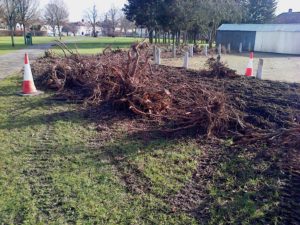
Northumberland Heath recreation ground, where shrub beds were ripped out early in 2017 despite the Council announcing more money for hedge maintenance. Given the proven importance of the park for declining House Sparrows, a metre or two of uncut grass around the margin of the park would provide them with more insects and seed to feed on. (Photo: Chris Rose)
It is particularly galling to note that during various budget consultations and park sell-off ‘consultations’ the Forum repeatedly proposed to the Council that it should save money and benefit wildlife by cutting less grass and less often across parks and open spaces, and that the ability to sustain the extra spend now announced has probably come, at least in part, from those sell-offs.
Given the amount of designated wildlife land in the Borough that this Council has approved building on over the last two years, and with residents still driving wildlife out of large numbers of front garden by smothering them with lifeless hard surfacing to park multiple vehicles, every extra dandelion that can manage to put up a few flowers and ever head of grass seed in a slightly longer sward is going to be of benefit.
The Council’s Parks and Open Spaces strategy says that it will improve a minimum of 15 sites for wildlife. A quick way to do that is for Cllr. Craske to chill out, keep off more grass and just let it grow.
As for the areas where there are rarer plants that do require more ‘grazing’ by the mowers to survive, local wildlife experts are happy to advise if the Council will listen and demonstrate some flexibility on what is cut, where and when. It’s not rocket science.
Money to recommence street tree planting and aftercare, and to support the setting up of new open space ‘Friends’ groups is welcome, however.
Chris Rose, Bexley Natural Environment Forum.
Back on February 16th a majority of Bexley Council’s Planning Committee voted with the chief planning officer’s recommendation to approve the Roxhill ‘Strategic Railfreight Interchange’ scheme on the southern part of Crayford Marshes, termed the landfill and agricultural area. This belated report highlights some of the issues and comments made, and lists who voted which way. There is still a lot of work to be done by pro-wildlife people, including on the developer’s rather woolly ‘management plan’ for the rest of the marshes area, and to help ensure the involvement of local people in that.
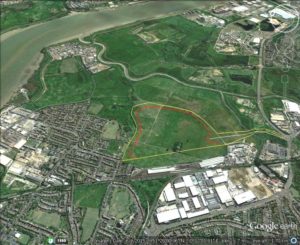
Google Earth image of the huge area to be lost to a railfreight depot now that Bexley Council has approved the plans. Red line – ‘developed’ area footprint, with screening bunds etc. out to yellow line. White line is main access roadway, including a bridge over the River Cray.
In another clear case of the severe pro-‘development’ bias in the UK planning system, no one voiced outright support for the scheme, but Councillors were clearly cowed by the prospect of losing any appeal if they voted no. There were very serious concerns and criticisms about the application and long-serving members said they couldn’t remember a report with so many conditions (of which there were 60) attached to a proposed outline approval. A core condition was that the rail connection had to go in first so that the site couldn’t simply be turned into a glorified warehousing/lorry park from the off.
In the light of this it was very disappointing that the central claim of a reduction in HGV traffic, the supposed ‘strategic’ reason why the government had decided that the Green Belt and wildlife designations should be over-ridden with regard to a former such scheme, was not questioned by Councillors or officers, all of whom had been sent Department for Transport projections of inexorable HGV traffic growth by objectors. Instead there was a focus on local traffic issues and train paths, none of which were going to be sufficient arguments to get the plan thrown out given the previous ruling.
Somewhat inevitably the developer’s ecologist claimed that the whole thing would be quite benign in ecological terms, using the land of ‘least value’. The logical consequence of repeatedly approving developments on the basis of this rationale somehow escapes these people, who conveniently forget to mention that modern conservation thinking recognises the need to protect larger, better-connected sites and to stop shrinking and fragmenting them.
Councillors from the local Ward get guaranteed speaking slots and up first was Northend Councillor Stef Borella (Lab). He pointed to the chequered history of the whole idea. This was a wonderful place, a fabulous habitat and he had received letters from residents across the whole Borough about it. The scheme should be refused and it was a disgrace that Green Belt was under threat. He thought there would be a lot of problems over train pathing. Cllr. Brenda Langstead (Lab) asked why a Shuttle bus was required from nearby Slade Green station if there were going to be a lot of jobs for local people. There would be more gridlock and pollution in an area already experiencing the worst air quality in Bexley. Somewhat unhelpfully, she proposed a by-pass for Slade Green to sort this out, without explaining quite where it would go.
Mr. Hillman, objecting for Slade Green Forum, had complained that the group had not been consulted about the proposed management plan for the rest of the marshes, that the supposed protection afforded to this was for way too short a period and that the whole issue of transfer of the remaining marshland and the tithe barn to a Trust has disappeared off the table.
Val Clark (Con) proposed that the plan be put to a vote, essentially saying that since the previous appeal was lost in favour of the developer, there was no point objecting now and the government was being quite clear it wanted these sorts of developments. Head of Planning Susan Clark said the Council had had to pay out £200,000 last time, that this was only an outline application, and some of the concerns of the ‘ecological lobby’ (as she now seems to have labeled us) could be dealt with later. In answering a question about how this scheme differed from the previous version of the same thing, she only mentioned a couple of supposedly positive changes, including the slightly smaller size, but neglected to point out the big negative ones mentioned by SGCF and the loss of the green roofs promise. Cafer Munur (Con), who has shown himself keen to get on and vote for more concrete in other recent attacks on key wildlife sites was quick to second going to a vote, claiming that the special circumstances were clear and now we would get real managed ecology.
Alan Deadman (Lab) bemoaned money ruling everything. He had no faith in the idea that anyone would stop HGVs from using non-designated routes to and from the site. He asked Councillors to remember why they had voted ‘no’ before, as all the reasons for that still applied now. At the very least he wanted a defferal to get more clarity on various issues.
Alan Downing (Con) was concerned about the wildlife and Green Belt, an inability as he saw it to actually manage the HGV traffic and the sway the financial benefit to the Council might be having over the decision-making (£2 million Community Infrastructure Levy cash plus future business rates) . The latter concern was echoed after the meeting by Labour Councillors who felt that mention of the financial inducements had been too prominent early in the meeting.
John Davey (Con) said there were two good things about this, money for managing the rest of the marshes and jobs, but a whole load of bad things. There would be a massive loss of open space and the Green Belt loss was an absolute disaster. He was convinced the Council would lose an appeal and have the matter taken out of its hands. Therefore he would vote ‘yes’ but hated having to do so.
June Slaughter (Con) raised a raft of concerns: inadequate protection for the amenity of residents, no guarantee of jobs for locals, cynical and unbelievable claims about traffic impacts which in reality would have a catastrophic effect on Thames Road, and the impacts on the environment. In her view the applicant’s claim that the scheme was ‘benign’ to wildlife was ‘almost an insult’. The 25 year funding for managing the rest of the marshes was not long enough. The previous permission had been granted 12 years ago. If this facility was so essential why had it still not been built? Protecting the environment has become even more important in the intervening period so simply equating the current situation with the previous decision was not valid. She thought the environmental effects were unacceptable and beyond the value of money.
Although we were being told that the ‘strategic importance’ of this scheme from a transport point of view over-rode the Green Belt and Site of Importance for Nature Conservation concerns Ben Thomas, the Biodiversity Officer in the Planning Department was present this time, having been absent from the Borax fields and Crayford Rough planning meetings where wildlife arguments were at the heart of the objections. He generously acknowledged that there would be ‘some loss’, but it was only a Borough level SINC and it was the poorest part of that that would be built on. Repeating the position he took on Erith Quarry, he maintained there would be a net benefit to biodiversity, in this case highlighting future control over water levels on the grazing marsh to the north. In this case it is conceivable that this could be true, but in the absence of any statement as to when enough ‘development’ will be enough, ultimately relies on the notion that you can keep on shovelling ever more of Bexley’s wildlife into ever less space with no serious negative consequences. As with Erith Quarry and other decisions since, no data was put into the public domain to illustrate just how this ‘net benefit’ conclusion had been reached. There was no mention of the importance of the agricultural and landfill SINC in question to farmland bird species which are in national decline, and no Council assessment of the size and impacts on the populations in the Borough Skylark and Corn Bunting across Bexley which are key in this regard. Susan Clark had merely mentioned in her report to the meeting that 2 Corn Bunting nesting sites would be affected, with no context whatsoever. The context being the massive national decline of Corn Buntings and the fact that a recently published work said that there are probably no more than 20 pairs left in the whole of London. Was this an ‘accident’ or deliberate bias? Given that it has taken the Council 3 years to deliberate on the results of the SINC review and decide that the affected site should be promoted from Borough Grade 2 to Grade 1, making it one of the best wildlife sites in our Borough, you have to wonder what is the point with a ‘defence’ like this.
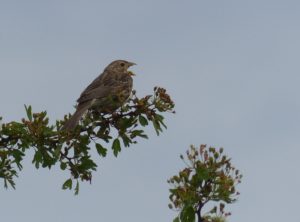
The Biodiversity Officer provided no data on the population size and breeding status of the red-listed Corn Bunting (or Skylark) in Bexley or London, and the absolute or relative impact this development would have on this situation. In our view this represents a failure to adhere to the Council’s legal biodiversity duty. (Photo by Ralph Todd)
Brian Bishop (Con) repeated the point about losing any appeal with the additional concern that some of the Council’s own conditions – with which he was satisfied – could be lost with it.
Joe Ferreira (Lab) thought politics was moving in the direction of stronger GreenBelt protection. Too many of the aspects that would be detrimental to residents were being left to conditions. He wasn’t going to support it.
Susan Clark came in again saying railfreight depots had been approved on Green Belt before, managed to avoid saying anything about the net increase in HGV traffic, argued that officers were ‘Doing our best for Bexley’ and essentially said that the Council was being forced into approval by the government.
Chair Peter Reader stressed the previous appeal decision and said that London Mayor Sadiq Khan won’t object subject to the right conditions.
No minute is taken of who voted for or against, and the votes happen too fast to write all the names down. As usual sorting out what happened is a matter of forensic analysis of the Council webcast, replaying key bits several times over because of the lack of sharpness of the image.
Those who definitely voted For, and this can be seen in the webcast, were:
Peter Reader, Brian Bishop, Christine Bishop, Val Clark, John Davey, Steven Hall, Cafer Munur, Colin Tandy, John Wilkinson (all Con) and Gill MacDonald (Lab).
The camera cut to the Chair on the Against vote. I wrote down that there were five against. Those who voted against were June Slaughter and Alan Downing (Con), Danny Hackett, Joe Ferreira and Alan Deadman (Lab).
As far as can be seen from the webcast James Hunt (Con) did not vote For, and there was no mention of an abstention, though this seems to be what he did.
For the record, London Assembly member for Bexley and Bromley, Gareth Bacon, did submit an objection in that capacity (rather than as a Bexley Councillor) after pressure was brought to bear over the fact that he and Zac Goldsmith had said they would protect all of Bexley’s Green Belt in a leaflet at the 2016 Greater London Assembly election . He said ‘I believe that a development on this scale would have a devastating impact on the local green belt, amounting to a severe loss of openness and encroachment onto the countryside [and] I believe the environmental harm of the proposal outweighs the economic benefits that flow from it and I believe the Council would be acting in the best interests of local residents if they were to refuse planning permission for this application’ . Bexley UKIP Councillor Lynn Smith also objected. Other objectors included the London Wildlife Trust, Bexley Natural Environment Forum (which has a number of constituent member groups), Bexley Civic Society, the LA21 Traffic and Transport Forum, London Green MEP Jean Lambert, Dartford MP Gareth Johnson and Bexley Green Party.
Nearly 150 ‘petition letters’ with space for personal comments were lodged, and 1,754 people signed the online petition against the planning application, with the link being sent to all members of the planning committee. Disappointingly only 6 personal letters of objection were sent to the Council – it is these that have most impact.
Much of the work on drumming up interest and objections from individuals and organisations was done by Donna Zimmer, to whom thanks.
The scheme might still founder like the last one for a variety of practical and economic reasons. As usual a yes vote isn’t end of story. More detailed plans will be submitted if the developer does plough on, and there will need to be pressure for things like green/brown roofs. Submissions will also be needed on the developer’s rather woolly ‘management plan’ for the rest of the marshes area, which is very short on detail and evidence of local knowledge, and to try and ensure the involvement local people with an interest and expertise in the marshes area and in its wildlife.
Chris Rose (Bexley Natural Environment Forum)
So warm and sunny was it on March 15th at Thames Road Wetland that although it felt like the kind of day the Lizards would start to come out in force, they didn’t begin to show on the old tyre basking sites until late in the afternoon. Particularly pleasing was the day-long activity of at least 8 Small Tortoiseshell butterflies, possibly 10 – a species that has suffered a major decline, but will have benefitted from the extensive Nettle bed at the east end of the wetland which is situated within what has been a relative hotspot for this insect in recent years. A Chiffchaff was seen, and was later heard singing. Spring was in the air.
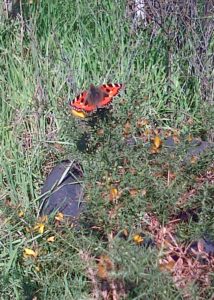
Small Tortoiseshells were much in evidence on the dryer banks surrounding the wetland. The number of sightings around Bexley this spring suggests that a modest recovery in numbers may be underway.
Some winter visitors were hanging on though – 2 Teal and a Snipe being inadvertently flushed.
The Sallow saplings were loaded with a haze of open flower spikes, attracting many bees, and also a Comma butterfly and one of the Small Tortoiseshells to feed on them. There were also 2 Peacock butterflies around, sometimes chasing the Tortoiseshells when they weren’t chasing each other. A small White butterfly just would not settle, but appeared to be the Small White itself and not the Green-veined White.
Other prominent spring flowers were the white of the Blackthorn and bright yellow of Lesser Celandine. Easier to overlook were the tiny blue flowers of the Early Forget-me-not (Myosotis ramosissima).
As usual a Cetti’s Warbler and a Water Rail were present. A Greenfinch was briefly heard calling from the sewer bank and a Song Thrush at dusk.
Chris Rose. Thames Road Wetland Site Manager for Thames21.
Thames Road Wetland, the River Wansunt and the Cray along By-way 105 benefitted from the efforts of Thames21 and St. Paul’s Academy in Greenwich on March 5th, as 19 bags of rubbish (including separated recyclables), wooden pallets, items of clothing, electrical equipment and over 20 car tyres were removed from the area. Much of the material had been dumped years ago, rather than being contemporary casual littering, so the improvement will be a permanent one now that the By-way is blocked to vehicles and fly-tipping here is no longer so easy.

Chris Rose and Joanna Barton with St. Paul’s Academy pupils pose alongside some of the rubbish collected.
The event, which was timed to contribute to the Great British Spring Clean, was led and supported by T21’s Cray and Marsh Dykes catchment staff Jess Becher and Joanna Barton, Thames Road Wetland Site Manager Chris Rose and the school’s Head of Geography Gordon Davis as part of his ‘outdoor classrooms’ initiative.
Joanna Barton/Chris Rose